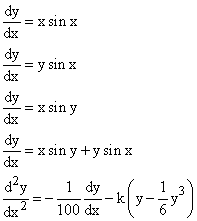| |
|||||
A differential equation is an equation involving derivatives. The order
of the equation is the highest derivative occurring in the equation.
The first four of these are first order differential equations, the last is a second order equation. The first two are called linear differential equations because they are linear in the variable y, the first has an "inhomogeneous term" that is independent of y on the right, the second is a homogeneous linear equation since all terms are linear in y. The first three of these are "separable" differential equations, since they can be rewritten as dx f(x) = dy g(y) for appropriate f and g. If you know only the derivative of a function, you do not have enough information to determine it completely. You can therefore seek either a solution to a differential equation, or a general solution (which usually has a constant for each order of the equation in it) or a solution subject to some additional condition or conditions. You can find the general solution to any separable first order differential equation by integration, (or as it is sometimes referred to, by "quadrature". All you need do is to integrate both sides of the equation dx f(x) = dy g(y). Thus you can apply the numerical techniques of the previous chapter to each of these directly and solve them numerically, if you cannot integrate them exactly. The question we address here is: suppose we have a first order differential
equation that is not separable, so we cannot reduce its solution to quadratures
directly. Can we apply the numerical techniques previously for doing integrals
to the task of solving these equations? The implication of this fact is, that any system whose behavior can be modeled by a first order differential equation, or even by a set of linked first order equations, can be solved numerically to any desired accuracy by a modern computer very quickly. This makes possible real time control of such systems and is of great value in engineering. |
||||||||||||||||||||||||||

